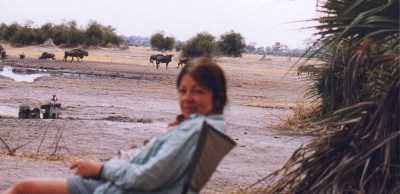Curing and Moving Cheetahs
A place like CCF has so much work that needs
to be done every day!

Besides caring for the healthy cheetahs,
there are some who are not healthy and require veterinary care.
One such case was a wild mother of two cubs,
who had injured her paw badly while she was in a trap.  Traps
seem to be common around the farms in Namibia, and I guess I am thankful for
that. The CCF encourages farmers not to kill but just to trap the cats if
they think they are threatening their livestock. When a farmer finds a
cheetah in the trap, he or she calls CCF. The CCF picks it up, cares
for it, and decides whether and where the cat can be released.
Unfortunately, the traps are not always checked frequently, and cheetahs
sometimes spend enough time in them to get extremely upset and hurt themselves.
Traps
seem to be common around the farms in Namibia, and I guess I am thankful for
that. The CCF encourages farmers not to kill but just to trap the cats if
they think they are threatening their livestock. When a farmer finds a
cheetah in the trap, he or she calls CCF. The CCF picks it up, cares
for it, and decides whether and where the cat can be released.
Unfortunately, the traps are not always checked frequently, and cheetahs
sometimes spend enough time in them to get extremely upset and hurt themselves.
 Once
"Paw", the wild mother, came back from the vet clinic in Otjiwarongo,
her paw had to be treated. Obviously, you don't treat a cat that size when
she's awake, so she had to be anesthetized. Even asleep, I could feel but
awe at being in a very small pen with such a powerful animal.
Besides treating her, she needed medication which was put in small pieces of
meat and hand-fed to her through a fence.
Once
"Paw", the wild mother, came back from the vet clinic in Otjiwarongo,
her paw had to be treated. Obviously, you don't treat a cat that size when
she's awake, so she had to be anesthetized. Even asleep, I could feel but
awe at being in a very small pen with such a powerful animal.
Besides treating her, she needed medication which was put in small pieces of
meat and hand-fed to her through a fence.
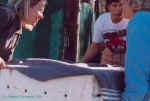 We
also had to move her cubs from their pen to hers. That was no easy
task. A crate with a cub in it can weigh probably over 100 lbs (60 kgs).
The other problem is to get the cub in the crate!
We
also had to move her cubs from their pen to hers. That was no easy
task. A crate with a cub in it can weigh probably over 100 lbs (60 kgs).
The other problem is to get the cub in the crate! 
These cubs are wild and will be released,
therefore they are kept sheltered from humans. We couldn't let them see
us. After a very stealthy operation, we were able to get cub # 1 in the
crate and take him to mom. Cub # 2, however, was not as easy. They
are so fast that the cub went in and out of the crate before we were able to
close it.
The crates were also useful to get the future
US cheetah citizens used to them. Our mission was to place crates in the feeding
pens, with a bit of food, so that the cubs would not be scared when they had to
be transported. 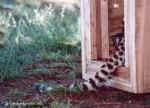 It
was fun to watch them exploring the crates. Bad Boy was the first one to
go in, but little by little, all of them got curious enough to follow suit.
It
was fun to watch them exploring the crates. Bad Boy was the first one to
go in, but little by little, all of them got curious enough to follow suit.
Old Lady also required medical
attention. Her ears had to be kept free of flies and other bugs. 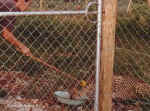 Karen,
a visitor from the White Oak Plantation in Florida, devised an ingenious way of
applying ointment on her ears. It was simple, a sponge attached to the end
of a stick. The device worked like magic and were were able to medicate
the dear lady's ears.
Karen,
a visitor from the White Oak Plantation in Florida, devised an ingenious way of
applying ointment on her ears. It was simple, a sponge attached to the end
of a stick. The device worked like magic and were were able to medicate
the dear lady's ears.
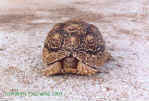 Occasionally,
other wildlife would come to visit, such as a leopard tortoise found by one of
the guys in the area. This tortoise might not have known that it had
arrived to the right place. The poor thing was full of ticks that our
visiting herpetologist, Pat, carefully removed from under its legs. Once
de-ticked, the tortoise was ready to go on its way and disappeared so fast that
we couldn't figure out which way it went!
Occasionally,
other wildlife would come to visit, such as a leopard tortoise found by one of
the guys in the area. This tortoise might not have known that it had
arrived to the right place. The poor thing was full of ticks that our
visiting herpetologist, Pat, carefully removed from under its legs. Once
de-ticked, the tortoise was ready to go on its way and disappeared so fast that
we couldn't figure out which way it went!
